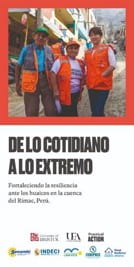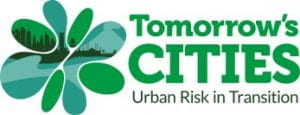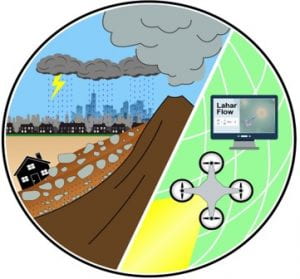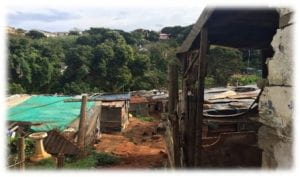My Current Projects:
From Everyday to Extreme: Strengthening Resilience to Frequent Flash Floods in Perú
 I lead this project, funded by the UK Global Challenges Research Fund (GCRF), which is working to improve preparedness and early warning systems for damaging flash floods (locally known as huaicos) in Perú. Huaicos are a frequent hazard in Perú, which have an attritional impact on development, and can result in significant destruction and loss of life in strong El Nino years.
I lead this project, funded by the UK Global Challenges Research Fund (GCRF), which is working to improve preparedness and early warning systems for damaging flash floods (locally known as huaicos) in Perú. Huaicos are a frequent hazard in Perú, which have an attritional impact on development, and can result in significant destruction and loss of life in strong El Nino years.
The project brings together academic mathematical modellers, social scientists and meteorologists with practitioners in hazard assessment, risk management, low-cost sensor design, film-making and participatory arts. We are developing new predictive capability to model and monitor huaico events, using freely-available modelling tools, and bringing together knowledge from national agencies and affected communities to increase the agency of both. We are using participatory arts to understand long-term drivers of risk in affected communities, and to develop community networks to lead preparedness planning. We are working directly with national agencies to understand how they interact in the management of huaico risk. We will integrate these outcomes into a community-based early warning system, trialled in two communities on the outskirts of Lima, and work to support its roll-out more widely in Perú.
More information on this project can be found here.
Tomorrow’s Cities – the GCRF Urban Disaster Risk Hub
 I am a co-investigator in this very large interdisciplinary Research Hub, focussed on bringing multi-hazard disaster risk management to the centre of urban policy and practice.
I am a co-investigator in this very large interdisciplinary Research Hub, focussed on bringing multi-hazard disaster risk management to the centre of urban policy and practice.
Globally, more than 2 billion people living in cities of low-to-middle income countries are exposed to multiple hazards such as floods, earthquakes, landslides, volcanoes and fires, which threaten the cyclical destruction of their lives and livelihoods. With urban areas expanding at unprecedented rates, this number is expected to reach 4 billion by 2050.
This project brings together 74 research partners across four global cities to reduce multihazard risk by
- Co-producing forensic examinations or root causes, drivers of vulnerability and trend analysis of decision-making culture for key, historic multi-hazard events.
- Combining quantitative, multi-hazard risk assessment to interface with urban planning culture and engineering.
- Convening diverse stakeholder groups – including communities, schools, municipalities, private enterprise and national agencies – around a new understanding of multi-hazard risk.
My work in this project is focussed on developing new predictive models for urban debris flows, flash floods and landslides, using freely-available modelling tools, and implementing them in city government to support planning and policy decisions.
More information on this project can be found here.
Quantitative Lahar Impact and Loss Assessment under Changing Land Use and Climate Scenarios
 I lead this Newton Fund project, aimed at enhancing assessment of lahar hazard in the Philippines and developing tools for assessing loss and risk from lahar activity. Lahars (volcanic mudflows) are a major global hazard, being responsible for 15% of the fatalities associated with volcanic hazards.
I lead this Newton Fund project, aimed at enhancing assessment of lahar hazard in the Philippines and developing tools for assessing loss and risk from lahar activity. Lahars (volcanic mudflows) are a major global hazard, being responsible for 15% of the fatalities associated with volcanic hazards.
Seasonal rainfall-triggered lahars are a very significant hydrometeorological hazard in the Philippines, with events occurring over more than decade following the 1991 eruption of Mt Pinatubo, currently following the eruption of Mt Mayon in 2018.
This project brings together mathematical modellers, volcanologists and hydrologists to adapt existing freely-available modelling tools for lahars, to make them suitable for quantifying loss and risk. We are developing new understanding of erosion of underlying surfaces by lahars, and its control on lahar dynamics. We have coupled hydrological and flow models for lahars to forecast lahar events driven by intense rainfall, and are calibrating the new models with detailed field observations from lahar events at Mayon. We are exploring the hydrodynamic stability of these models, and developing new understanding of the dynamics of their impacts on buildings and engineered structures. We are working to embed this new capability in the REDAS risk management system developed for the Philippines by the Philippine Institute of Volcanology and Seismology, and into loss estimation schemes used by the insurance industry.
More information on this project can be found here.
GCRF Challenge Cluster – Risk at the Margins (RAM): a blueprint for defragmenting disaster risk reduction with populations at risk
 I am a co-investigator in this project, which aims to develop combined technological and ‘citizen science’ methods to reduce disaster risk for those affected. It focuses primarily on extensive hazards: small-scale, high frequency events, which can be locally catastrophic.
I am a co-investigator in this project, which aims to develop combined technological and ‘citizen science’ methods to reduce disaster risk for those affected. It focuses primarily on extensive hazards: small-scale, high frequency events, which can be locally catastrophic.
Extensive hazards such as drought, ashfall, landsliding, pollution are responsible for 42% of the economic impact of natural hazards in lower and middle income countries, and can generate negative outcomes that are more damaging to sustainable development than infrequent high cost events, particularly for populations with other vulnerabilities.
The project brings together experts in the physical and social science of natural hazards with technologists, designers and affected communities to explore successful and unsuccessful integration of scientific and community knowledges and actions to reduce disaster risk. Case study research in Nepal, Dominica and South Africa is creating new technological approaches to hazard monitoring and prediction in parallel with new understanding of initiatives at community level needed to make these technologies effective.
More information on this project can be found here.
Selected Completed Projects:
Strengthening Resilience in Volcanic Areas (STREVA)
 I was a co-investigator and leader of the hazards modelling component of this interdisciplinary project, which developed and applied practical and adaptable means to analyse volcanic risk. New knowledge from the project has been used to generate plans that will reduce the negative consequences of volcanic activity on people and assets.
I was a co-investigator and leader of the hazards modelling component of this interdisciplinary project, which developed and applied practical and adaptable means to analyse volcanic risk. New knowledge from the project has been used to generate plans that will reduce the negative consequences of volcanic activity on people and assets.
STREVA aimed to characterise key elements of dynamic volcanic risk, starting by understanding drivers of risk in previous volcanic emergencies in three study regions, in Ecuador, Colombia and the Caribbean. The project explored new methods to forecast and communicate eruptions and changes in activity during eruptions, improved methods including freely-available modelling tools to identify areas at risk from volcanic hazards (primarily lahars and volcanic ash), and how to improve understandings of the social, political and institutional drivers of volcanic risk.
Much more information on this project can be found here.
The Consortium on Risk in the Environment: Diagnostics, Integration, Benchmarking, Learning and Elicitation (CREDIBLE)
I was a co-investigator in this project which focussed on improving the understanding of uncertainty in quantification and predictive modelling of a wide range of weather-related and geophysical hazards. The project developed new tools and methods to improve the handling of uncertainty in relation to natural hazards, by both scientists and stakeholders, and to improve communication between the science and stakeholder communities.
My work in this project focussed on uncertainty quantification for freely-available predictive models of lahars (volcanic mudflows) and volcanic plumes. A summary of the lahar case study is available here.
More information on this project can be found here.
List of All Projects:
2020 Ixchel: Building understanding of the physical, cultural and socio-economic drivers of risk for strengthening resilience in the Guatemalan cordillera GCRF Multihazards and risks CoI
2020 GCRF Challenge Cluster – Risk at the Margins (RAM): a blueprint for defragmenting disaster risk reduction with populations at risk GCRF Challenge Cluster CoI
2019 Integrating Scientific and Community Knowledges for Disaster Risk Reduction University of Bristol Research Fellowship
2019 From Everyday to Extreme: Strengthening Resilience to Frequent Flash Floods in Perú GCRF Investment Fund Institutional Sponsorship PI
2019 GCRF Research Hub: Urban Multi-Risk Transitions Bristol PI
2018 Quantitative Lahar Impact and Loss Assessment under Changing Land Use and Climate Scenarios Newton Fund Hydrometeorological Hazards in SE Asia PI
2017 Strengthening Capacity for Mitigation of Huayco (Flash Flood) Impacts in Perú Newton-Paulet Fund PI
2017 Supporting Recovery from 2017 Coastal El Nino Sediment-laden Floods in Peru EPSRC-GCRF Institutional Sponsorship PI
2017 Nato technical report consultancy DSTL CoI
2016 Harnessing ‘citizen science’ to reinforce resilience to environmental disasters: creating an evidence base and community of practice GCRF Building Resilience CoI
2015 Crossing Borders and Costing Livelihoods; The Unbearable Heaviness of Volcanic Ash NERC International Opportunities Funding CoI
2015 Volcanic Ash Impact on Nuclear Generating Facilities EDF Energy Nuclear Generation Ltd. PI
2014 Volcanic Ash Hazard for UK Nuclear Generating Facilities NERC Environmental Risks to Infrastructure PI
2012 The Consortium on Risk in the Environment: Diagnostics, Integration, Benchmarking, Learning and Elicitation (CREDIBLE) NERC PURE CoI
2012 A Geophysical Supersite for Iceland (FUTUREVOLC) EU FP7 Bristol PI
2012 Strengthening Resilience in Volcanic Areas (STREVA) NERC IRNH consortium grant Bristol PI 80%
2011 Understanding Geophysical Granular Flows: from Small-scale Experiments to Full-scale Simulations EU FP7-PEOPLE-2011-IEF Marie Curie Fellowship for Dr Lydie Staron
2010 Characterisation of the Near-Field Eyjafjallajökull Volcanic Plume and its Long-range Influence NERC Consortium Grant CoI
2009 Gas-Melt Flow Regimes in Basaltic Volcanic Conduits and their Characteristic Acoustic Signals NERC Standard Grant CoI
2008 Dynamics at Persistently Degassing Basaltic Volcanoes: A Novel Approach to Linking Volcanic Gases and Magmatic Volatiles within a Physical Model NERC Standard Grant PI
2008 Using Positron Emission Particle Tracking to Investigate Sorting in Geological Flows Royal Society Research Grant PI
2008 The Dynamics of Short-duration, Unsteady Volcanic Eruptions NSF Standard Grant CoI
2006 Integrating Numerical and Laboratory Models of Explosive Eruptions with Field Observations: Understanding Pyroclastic Transport NSF-EAR Workshop Grant CoI
2005 Dynamics of Vulcanian Volcanic Eruptions NSF-SGER CoI
2005 The Interaction of Gas-bearing Basaltic Magma with a Horizontal Tunnel Southwest Research Institute PI

